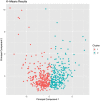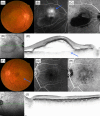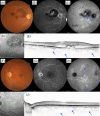Deep phenotype unsupervised machine learning revealed the significance of pachychoroid features in etiology and visual prognosis of age-related macular degeneration
- PMID: 33116208
- PMCID: PMC7595218
- DOI: 10.1038/s41598-020-75451-5
Deep phenotype unsupervised machine learning revealed the significance of pachychoroid features in etiology and visual prognosis of age-related macular degeneration
Abstract
Unsupervised machine learning has received increased attention in clinical research because it allows researchers to identify novel and objective viewpoints for diseases with complex clinical characteristics. In this study, we applied a deep phenotyping method to classify Japanese patients with age-related macular degeneration (AMD), the leading cause of blindness in developed countries, showing high phenotypic heterogeneity. By applying unsupervised deep phenotype clustering, patients with AMD were classified into two groups. One of the groups had typical AMD features, whereas the other one showed the pachychoroid-related features that were recently identified as a potentially important factor in AMD pathogenesis. Based on these results, a scoring system for classification was established; a higher score was significantly associated with a rapid improvement in visual acuity after specific treatment. This needs to be validated in other datasets in the future. In conclusion, the current study demonstrates the usefulness of unsupervised classification and provides important knowledge for future AMD studies.
Conflict of interest statement
The authors declare no competing interests.
Figures





References
-
- Scholl S, Kirchhof J, Augustin AJ. Role of inflammation in the pathogenesis of age-related macular degeneration. Expert Rev. Ophthalmol. 2009;4:617–625. doi: 10.1586/eop.09.51. - DOI
MeSH terms
Substances
LinkOut - more resources
Full Text Sources
Medical

